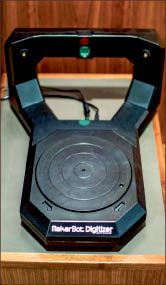Taking it to another dimension

Advanced 3D technology promises revolution in research and collaboration
The Jerry Falwell Library at Liberty University has made a new addition to its array of cutting-edge research tools.
The department of scholarly communications installed a Makerbot 3D scanner in the Scholar’s Commons in early March.
With a turntable and advanced laser technology, the new scanner can digitally render objects into 3D models directly to a computer.
Its use is not limited to any department, student or faculty.
“An art student could scan his or her sculpture and project it on a big screen for a presentation, or a student with FACS (Family and Consumer Sciences) who’s designing, say, a belt buckle, could use it,” scholarly communications assistant Joshua Waltman said.
“You can’t take a small buckle and just pass it around the room for a presentation, but you can throw a 3D model up on the screen.”
The scanner is not only part of the library’s mission to expand its research tools, but it is also part of a greater mission of expanding collaboration.
“A lot of people think of a library as just a place with a bunch of books,” Waltman said.
“Our library is not just a place for books. It’s a place for creativity. It’s a space where people can come work, do scholarship and explore their disciplines. This new scanner falls right in line with that.”
One thing the department of scholarly communications does is manage a storehouse of student and faculty research publications.
The repository is responsible for making articles and material available online, through search engines such as Google.
However, the long-standing challenge facing the department and repository has been finding a method of presenting nontraditional scholarship online.
That is where the Makerbot 3D scanner comes in.
The process of acquiring the scanner started in the summer of 2015. Hannah Lowder, librarian for the department of cholarly communications, served as the primary researcher in justifying the purchase and installation of the scanner.
She explained how utilizing technology like the Makerbot scanner has become a growing trend among other libraries, as it promotes a new realm of scholarly discovery, presentation and publication.
The installation of the scanner at the Jerry Falwell Library has served as an extension of the relatively new building itself.
Such technology provides the needed space for collaboration and innovation.
“We’re always looking for new ways to build upon the theme of collaboration,” Lowder said. “That was one of the motivating factors behind getting the library’s robotic system, too.”
The Makerbot scanner will allow students and faculty alike to provide visual appeal to projects and presentations.
For instance, scholarly communications connected with the biblical museum in the library’s basement over the scanner.
Now, anyone can scan certain artifacts from the museum into digital format for research.
Students can study artifacts without worry of breaking or over-handling the items.
The research capabilities of the scanner transcend departments or degree programs.
Scholarly potential and usage is not limited to the scanner itself.
Waltman said the 3D scanner in the library could easily be coupled with the 3D printer at the Liberty School of Engineering.
Also paired with the service of the machine is the service of the people working in scholarly communications.
“We can give students or faculty consultations about how they could possibly use the scanner for their projects,” Lowder said. “We’re willing to provide training, but we’re hoping that people can feel free to just walk up and use it.”
Pavel Vasioutovitch, associate dean of library technologies and collection services, explained the dual goal in the installation of the scanner: promoting the partnership of different departments within the school and promoting the partnership of researchers with the services of scholarly communications.
Thus, the scanner markets both material resources and human resources.
“If you want to follow this development in any way, follow it as a chain of events,” Vasioutovitch said, referring to future technological innovations within the library.
“This scanner is just a starting point. The capabilities that the scholarly communications people bring to the table are far greater than the capabilities that the scanner can bring.”
jarrett is a news reporter.
